Moog Components Group
-
- From Tiny Electrical Impulses Grows a $2.6B Giant MOOG Marine Technology, Jul 2013 #74
In 1951 William (Bill) Moog developed the electro-hydraulic servovalve that translates tiny electrical impulses into precise and powerful movement. Moog, an inventor, entrepreneur and visionary, likely knew then that valve would open the flood gates that would transform a small workshop in East Aurora, New York into the corporate giant Moog Inc. is today.
Bill Moog, along with his brother Arthur and Lou Geyer, formed the Moog Valve Company, and their first four servovalves were sold to Bendix Aviation. That order was followed by larger orders from Boeing and Convair. Moog had made a significant move into the aerospace industry and has never looked back.
Today, Moog Inc. employees 8,000 people around the world and has revenues of $2.6B. The Moog vision has been to diversify and although the main focus of the company has been the aerospace industry serving the commercial aircraft industry, military and defense and even supplying highly sophisticated components for the U.S. Space program, Moog also supplies and manufactures components for a variety of industrial, medical, marine and energy applications. And through initiative and innovation, Moog staff have created new products for these various industries that have been both customer specific and for a broader based customer use.
The diversification has led to Moog’s acquisition around the world of leading companies producing top quality products that would complement and expand the various Moog product lines. Such was the case with Focal Technologies of Halifax, a marine product company, which in 2005 became part of the Moog Components Group and now the base of its marine operations. “This facility is almost 100% marine. Nearly everything we do here is marine and energy solutions,” said Moog Focal’s Managing Director Michael Glister, who explained how Focal became a good fit for Moog.
Focal actually started as part of the Nova Scotia Research Foundation, said Glister. With a private owner, the company grew and settled in Burnside, an industrial park across the harbor from Halifax. In 1999 Focal was sold to the U.S.-based Kaydon Corp.
“They were looking for slip ring manufacturers,” said Glister. “They didn’t really understand that although we made slip rings we are very much a marine company. Being a slip ring manufacturer was not our main objective.”
In 2005 Kaydon sold Focal to Moog.
“They were looking for diversification, adding technologies that they thought were adjacent to their own and synergistic with their own. So we are part of Moog but still keep the Focal brand name because it has a very strong brand identity within the marine business. So we are Moog Focal and a business segment of the Moog Components Group,” said Glister.
When Focal came out of the Nova Scotia Research Foundation, its concentration was in a couple of areas, said Glister. One of those areas was the use of fiber optics for marine and subsea applications and its first application was a towed array for the Canadian submarines. The other area was developing an electrical slip ring for marine use. They would typically be deployed in the winch of some type of marine system.
Glister offered this example.
“If a ship was to deploy something underwater, it would tail out from a winch. It would have a situation where the cable coming into the winch would be static but having to convert to the rotary side of that cable winch as it deploys the cable into the ocean. Our devices initially were mainly to convert any type of power or signal from the stationary world to the rotational world and that’s what most of our products do today but to that we have added many more fiber optic capabilities,” he said.
Glister, a native of England (and a citizen of Canada) and a design engineer by profession, said fiber optics send signals through photons of light and can carry much more data and transfer it further than electricity.
“So we make many parts for fiber optic systems that are used underwater. A very typical one is you have an underwater robot (ROV) that is doing maintenance. It may be a wellhead on the ocean floor or a sunken wreck they want to have a look at. There may be other types of inspection like on a pipeline checking for cracks, ocean bed debris covering the pipe, etc. They send down these robots with cameras, sonar and other sensors. They use and produce a lot of data, therefore, we supply fiber optic systems for ROVs plus electrical power systems. Those are two main products - fiber optics and electrical power - and they are all made here. Other products made here include very large electrical power swivels for floating oil platforms and we do what is called a fluid rotary union, the fluid equivalent of a slip ring. So we have basically four major disciplines in the (Burnside) building making advanced technology products for the underwater business,” said Glister.
Creating advanced technology for marine applications is an ongoing process at Moog Focal’s Nova Scotia facility. Research and development are part of the company’s engrained culture.
“Out of approximately 190 people in this building we have about 45 in engineering and about another 15 in what we call production engineering,” said Glister. “So we have about 60 engineers and technologists doing a lot of development. At anytime there is at least 20 new product developments going on in the building. It could be for one customer or a product we are trying to sell across the total marine market,” he said.
Some of Moog Focal’s developments include a fiber optic rotary joint for use with a ship’s winch, “which basically you can put a stationary fiber on one end, a rotating fiber on the other end and it converts the signal without any degradation. We are pretty well the world leader that in that product,” said Glister.
“Another product we make is the media converter. Once you have the fiber optic system in place, eventually that fiber optic signal has to become electrical again so it can go into a camera, computer or something of that nature. We also make a lot of the very clever electronics and optical systems which convert from the optical into the electrical world and back. You might have 10 or 20 electrical signals and that doesn’t add up to that much data. But it is collected together and sent down one fiber. The system then reassembles them into individual signals and converts them back to electrical. These are called multiplexers and we are possibly the world’s leading supplier of underwater multiplexer systems,” said Glister. They are used in the exploration and production of oil and gas, scientific research and many other subsea applications.
In 2012 Moog added to its marine portfolio with the acquisition of Tritech International Ltd. of Scotland.
“Tritech is part of the marine products operation of Moog Components Group,” said Glister. “We (Focal) are doing all the work that provides the communication and the power products while Tritech adds something adjacent and that is sonar and sensing. They have a number of products for people trying to navigate or guide themselves in underwater situations. You can’t use radar or GPS, none of those work underwater, so the main types of sensors used are acoustic instruments, like sonar, altimeters and other instruments that use acoustic wave lengths. They also make some cameras and lights and a few other sensors as well,” Glister said. “So we are adding the Tritech sonar and other sensors and also they do all the software that interprets these signals and turns them into images. So this expands our marine section. Focal and Tritech are in the same market but with slightly different technology,” he added.
Moog’s marine division is an approximate $80 million a year business and is growing.
“When I came here in 2001 the company was around $10 million. This year alone in this building we will grow substantially,” said Glister.
Greg Boyer, Moog’s Vice President of Sales and Marketing in Blacksburg, Virginia, said the marine market represents about 15% of the Moog Components Group’s business.
Surprisingly, very little of Moog’s marine products stay in Canada.
“With the marine business and predominately with oil and gas, it has always been a very international business so we retain less than 1% of our output in Canada. The rest is all exported to other countries. Either into the U.S. and mainly for Gulf of Mexico, the North Sea area of Europe, offshore Brazil, the West Coast of Africa, Northern Australia and some areas of Asia,” said Glister.
However, there is some potential for Moog Focal close to home. British Petroleum and Shell are ramping up for major offshore oil and gas exploration off Nova Scotia and Moog Focal could quite likely have product involved in all facades of that work from seismic to drilling to production.
Boyer added that, “We try to grow in synergistic steps and the next area that we see substantial growth is in the supply of our equipment to subsea wellheads and drilling systems.”
But like any other company constantly striving for excellence, there are challenges and being a world leader makes the task greater.
“If you are going to perform underwater, you can’t have a product that is going to fail in any shape or form,” said Glister, because that failure could cost the user of the product hundreds of thousands of dollars. And, of course, the manufacturer’s reputation.
“So there is the absolute need to perform and that is the competitive side of the business,” he said. “We are also becoming a little bit dollar conscious because costs are going up like crazy in oil and gas production markets so we are watching our pennies. But mainly we spend money to make our products high performance with a focus on excellence,” he said.
Glister said the company is constantly on the lookout for top notch talent to work in the Moog environment that has a reputation of treating its employees with trust and respect.
Boyer sees finding well-trained technologists and engineering graduates suitable for the marine industry a most pressing issue.
“In the long term, it will be adapting to the change in oil sources from standard oil and gas wells to shale, coal bed methane and similar non-conventional sources,” he said.
Overall, Glister sees a bright future for Moog’s marine division.
“As far as I can see, the underwater technology sector will grow, and I think we have a future in growing with it here in Halifax. We certainly see a good future in what we do and we are focused on adding to that. It’s a fun thing to be in,” he added.
(As published in the September 2013 edition of Marine Technology Reporter - www.seadiscovery.com)
-
 )
March 2024 - Marine Technology Reporter page: 45
)
March 2024 - Marine Technology Reporter page: 45ronments. The new agreement will address speci? c techni- cal gaps in the UUV defense and offshore energy markets especially for long duration, multi-payload mission opera- tions where communications are often denied or restricted. As part of the new alliance, Metron’s Resilient Mission Autonomy portfolio
-
 )
March 2024 - Marine Technology Reporter page: 44
)
March 2024 - Marine Technology Reporter page: 44NEW TECH OCEANOLOGY INTERNATIONAL 2024 Image courtesy Metron/Cellula Teledyne Marine acquires Valeport: Matt Quartley, MD, Valeport and Ole Søe-Pedersen, VP & Image courtesy Teledyne Marine GM Teledyne Marine announce the deal in London. Pictured (L-R): Cellula Robotics, President, Eric Jackson, Metron
-
 )
March 2024 - Marine Technology Reporter page: 41
)
March 2024 - Marine Technology Reporter page: 41Image courtesy Outland Technology Image courtesy Exail Image courtesy Submaris and EvoLogics Vehicles The ROV-1500 from Outland Technology represents a leap forward in underwater robotics, a compact remotely operated vehicle (ROV) weighing in at less than 40 lbs (19kg) the ROV- 1500 is easy to transport
-
 )
March 2024 - Marine Technology Reporter page: 29
)
March 2024 - Marine Technology Reporter page: 29n January, Norway said “yes” to sea- bed mining, adding its weight to the momentum that is likely to override the calls for a moratorium by over 20 countries and companies such as I Google, BMW, Volvo and Samsung. Those against mining aim to protect the unique and largely unknown ecology of the sea?
-
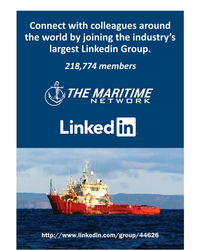 )
March 2024 - Marine Technology Reporter page: 21
)
March 2024 - Marine Technology Reporter page: 21Connect with colleagues around the world by joining the industry’s largest Linkedin Group. 218,774 members http://www.linkedin.com/group/44626 MTR #3 (18-33).indd 21 4/4/2024 3:37:21 PM
-
 )
March 2024 - Marine Technology Reporter page: 6
)
March 2024 - Marine Technology Reporter page: 6MTR Editorial Advisors Gallaudet Hardy The Honorable Tim Gallaudet, Kevin Hardy is President PhD, Rear Admiral, U.S. of Global Ocean Design, Navy (ret) is the CEO of creating components and Ocean STL Consulting and subsystems for unmanned host of The American Blue vehicles, following a career
-
 )
April 2024 - Maritime Reporter and Engineering News page: 48
)
April 2024 - Maritime Reporter and Engineering News page: 48Index page MR Apr2024:MN INDEX PAGE 4/5/2024 1:33 PM Page 1 ANCHORS & CHAINS MILITARY SONAR SYSTEMS tel:+44 (0) 1752 723330, [email protected] , www.siliconsensing.com Anchor Marine & Supply, INC., 6545 Lindbergh Houston, Massa Products Corporation, 280 Lincoln Street, SONAR TRANSDUCERS
-
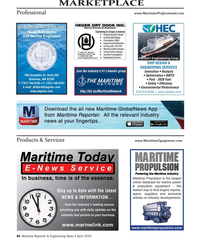 )
April 2024 - Maritime Reporter and Engineering News page: 46
)
April 2024 - Maritime Reporter and Engineering News page: 46MARKETPLACE Professional www.MaritimeProfessional.com GILBERT ASSOCIATES, INC.GILBERT ASSOCIATES, INC. Naval Architects and Marine Engineers SHIP DESIGN & ENGINEERING SERVICES Join the industry’s #1 Linkedin group )NNOVATION
-
 )
April 2024 - Maritime Reporter and Engineering News page: 43
)
April 2024 - Maritime Reporter and Engineering News page: 43“The industry is an ecosystem which includes owners, managers, mariners, shipyards, equipment makers, designers, research institutes and class societies: all of them are crucial,” – Eero Lehtovaara, Head of Regulatory & Public Affairs, ABB Marine & Ports All images courtesy ABB Marine and Ports provi
-
 )
April 2024 - Maritime Reporter and Engineering News page: 38
)
April 2024 - Maritime Reporter and Engineering News page: 38Tech Files Latest Products, Systems and Ship Designs Zero-Emission Mooring Service of a Tanker Consulmar achieved a milestone by executing what it calls ing boat Castalia, which operates on full electric propulsion. the world's ? rst zero-emissions mooring service for a tanker. Equipped with two 150 kW
-
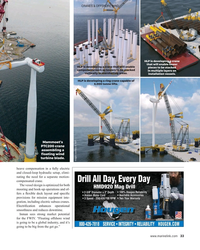 )
April 2024 - Maritime Reporter and Engineering News page: 33
)
April 2024 - Maritime Reporter and Engineering News page: 33CRANES & OFFSHORE WIND HLP is developing a crane that will enable tower HLP is developing a crane that will enable pieces to be stacked components such as towers to be stacked in multiple layers on vertically in marshalling areas. installation vessels. HLP is developing a ring crane capable of 6
-
 )
April 2024 - Maritime Reporter and Engineering News page: 32
)
April 2024 - Maritime Reporter and Engineering News page: 32FEATURE A closeup of a blade installation process taken via drone. A blade handling system is apparent (in yellow). Images courtesy of Mammoet requirement for the development of these cranes, particularly ling area. This would result in a major time and fuel saving. in ? oating offshore wind,” says
-
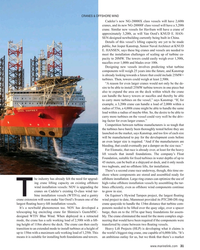 )
April 2024 - Maritime Reporter and Engineering News page: 31
)
April 2024 - Maritime Reporter and Engineering News page: 31CRANES & OFFSHORE WIND Cadeler’s new NG-20000X class vessels will have 2,600t cranes, and its new NG-20000F class vessel will have a 3,200t crane. Similar new vessels for Havfram will have a crane of approximately 3,200t, as will Van Oord’s KNUD E. HAN- SEN-designed newbuilding currently being built in
-
 )
April 2024 - Maritime Reporter and Engineering News page: 27
)
April 2024 - Maritime Reporter and Engineering News page: 27RADM PHILIP SOBECK, MILITARY SEALIFT COMMAND With COVID, we had to make some hard choices for our Do your CIVMARs have upward mobility? mariners because we couldn’t rotate. Many of our mariners The Navy has Sailors who become “Mustangs,” and work found other employment, and were able to use their skills
-
 )
April 2024 - Maritime Reporter and Engineering News page: 13
)
April 2024 - Maritime Reporter and Engineering News page: 13from gasoline to methanol, but compared to just buying an EV After some pondering, I think I can reduce it to this logi- today that is a pointless exercise. It would actually make more cal sequence: sense to buy a plug-in hybrid that is con? gured for methanol It is the carbon. We want zero carbon as
-
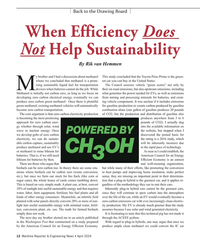 )
April 2024 - Maritime Reporter and Engineering News page: 12
)
April 2024 - Maritime Reporter and Engineering News page: 12Back to the Drawing Board When Efficiency Does Not Help Sustainability By Rik van Hemmen y brother and I had a discussion about methanol This study concluded that the Toyota Prius Prime is the green- where we concluded that methanol is a prom- est car you can buy in the United States. ising sustainable
-
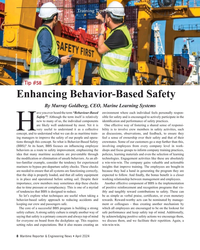 )
April 2024 - Maritime Reporter and Engineering News page: 8
)
April 2024 - Maritime Reporter and Engineering News page: 8Training Tips for Ships © By tuastockphoto/AdobeStock Tip #58 Enhancing Behavior-Based Safety By Murray Goldberg, CEO, Marine Learning Systems ave you ever heard the term “Behaviour-Based environment where each individual feels personally respon- Safety”? Although the term itself is relatively sible for
-
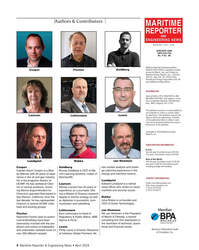 )
April 2024 - Maritime Reporter and Engineering News page: 4
)
April 2024 - Maritime Reporter and Engineering News page: 4Authors & Contributors MARITIME REPORTER AND ENGINEERING NEWS M A R I N E L I N K . C O M ISSN-0025-3448 USPS-016-750 No. 4 Vol. 86 Maritime Reporter/Engineering News (ISSN # 0025-3448) is published monthly Cooper Fischer Goldberg except for March, July, and October by Maritime Activity Reports, Inc.
-
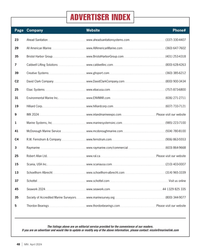 )
April 2024 - Marine News page: 48
)
April 2024 - Marine News page: 48ADVERTISER INDEX Page Company Website Phone# 23 Ahead Sanitation www.aheadsanitationsystems.com (337) 330-4407 29 All American Marine www.AllAmericanMarine.com (360) 647-7602 35 Bristol Harbor Group www.BristolHarborGroup.com (401) 253-4318 7 Caldwell Lifting Solutions www.caldwellinc.com (800)
-
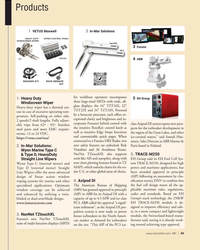 )
April 2024 - Marine News page: 43
)
April 2024 - Marine News page: 43Products 1 2 VETUS Maxwell In-Mar Solutions 3 Furuno ABB 4 for workboat operators encompasses EH Group 1. Heavy Duty 5 three large-sized MFDs with wide, all- Windscreen Wiper glass displays: the 16” TZT16X, 22” Heavy-duty wiper has a thermal cut- TZT22X and 24” TZT24X. Powered out in
-
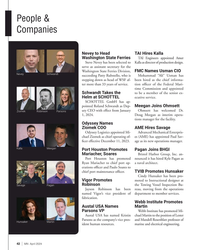 )
April 2024 - Marine News page: 42
)
April 2024 - Marine News page: 42People & Companies Nevey to Head TAI Hires Kalla Washington State Ferries TAI Engineers appointed Amer Steve Nevey has been selected to Kalla as director of production design. serve as assistant secretary for the FMC Names Usman CIO Washington State Ferries Division, Nevey Schwandt succeeding Patty
-
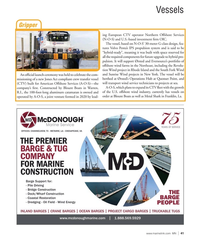 )
April 2024 - Marine News page: 41
)
April 2024 - Marine News page: 41Vessels Gripper ing European CTV operator Northern Offshore Services (N-O-S) and U.S.-based investment ? rm OIC. The vessel, based on N-O-S’ 30-meter G-class design, fea- tures Volvo Penta’s IPS propulsion system and is said to be “hybrid-ready”, meaning it was built with space reserved for all the
-
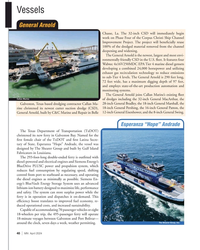 )
April 2024 - Marine News page: 40
)
April 2024 - Marine News page: 40Vessels General Arnold Chasse, La. The 32-inch CSD will immediately begin work on Phase Four of the Corpus Christi Ship Channel Improvement Project. The project will bene? cially reuse 100% of the dredged material removed from the channel deepening and widening. The General Arnold is the newest,
-
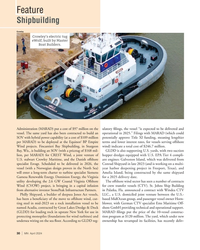 )
April 2024 - Marine News page: 30
)
April 2024 - Marine News page: 30Feature Shipbuilding Crowley Crowley’s electric tug eWolf, built by Master Boat Builders. Administration (MARAD) put a cost of $97 million on the ulatory ? lings, the vessel “is expected to be delivered and vessel. The same yard has also been contracted to build an operational in 2025.” Filings with
